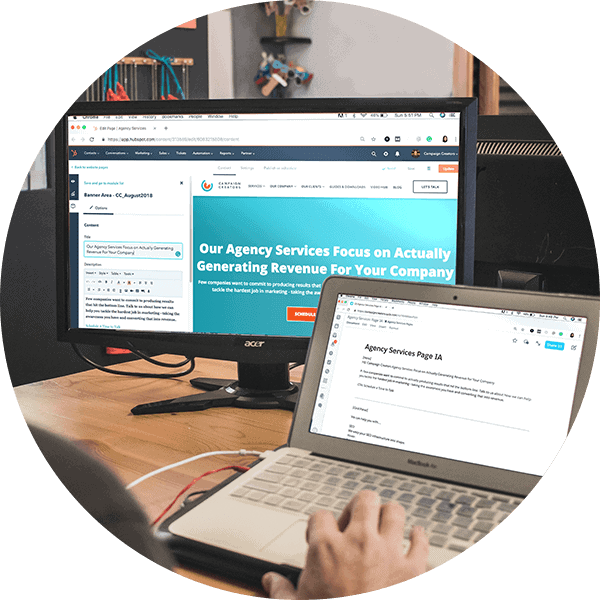
3 Questions To Ask Yourself When Working With A Consultant
March 23, 2017
3 Essential Steps When Starting a Company Blog
May 4, 2017
Last week we mentioned that in addition to tried-and-true consulting firms who truly have your best interest at heart, there are also less-than-savory consultants out there who send you bogus reports from cockamamie websites trying to prove to you that your website is on its last leg and you simply cannot go another day without their expertise.
Unfortunately, to the untrained eye, these dummy reports and smooth-talking salesmen can look pretty compelling.
If you start looking into your own stats—from reputable sources like Google Analytics or your marketing automation software—you’ll be familiar with your company’s data, and therefore you should be a little better about being able to pick out the professional companies from the snake oil salesmen.
So, while this isn’t necessarily a comprehensive list, looking at these metrics is sure to give you at least a high-level overview of how your marketing efforts are going:
#1.) Site Visits
Take a look to see how many people visited your site this month and compare what you see to last month’s number and even the number of visitors from the same month of the previous year. Over time you want to see a trend upwards with more and more visitors each month.
You should also break down site visitors by source (organic, direct, email, social media, referral, etc.) to see which channels are pulling the most site visitors and the most contacts. This will allow you to see where your hard work is paying off as well as where you might need to be putting in a little more effort.
#2.) Bounce Rate
Bounce Rate is when a web visitor (read: potential customer) comes to your website and EXITS without going to any other page. It’s a measure of how effective your website’s first impression is. We generally like to see this number stay below 50%.
You can also evaluate your bounce rates by channel. Some you should expect to be high (direct traffic, for example), while other’s you’ll want to make sure stay low (organic).
#3.) Average Time on Site & Average Pages Viewed
So, for those that don’t bounce and who choose to stay on your site, it’s good to know how long they’re staying and how many pages they’re viewing. This is a good measure of how compelling your site content is and how well your sales funnels drive people through the site.
#4.) Top Pages
Your homepage is likely going to be your most popular page; that’s almost always a given. Aside from that, take a look at which other pages are performing well. These top pages indicate not only which pages of yours are most likely to be ranking well, but also the content site visitors/potential leads/potential customers are seeking out and find the most valuable.
#5.) Campaign Performance
If you’re running premium campaigns with special landing pages, offers, and dedicated paid ads, you’ll want to know if all of your efforts to get the campaign pulled together are paying off. Are your landing pages getting views? Are people actually filling out the form to access the downloadable offer? If not, this is a sign you might need to rework some things and start resharing.
#6.) Blog Performance
If you’re anything like me, you spend most of your workday staring at the business end of your business’ blog. If you aren’t the blog writer, you’re at least paying someone else to make blogging their favorite, so you need to know that the time, effort, and money being spent on your blog is worth it.
Make note of the number of blog articles you published over the last month, your top-viewed articles, and your number of blog subscribers. The most important metric I just mentioned was top-viewed articles. Much like your top pages, these indicate the content site visitors/potential leads/potential customers are seeking out and find the most valuable.
#7.) Landing Page Performance
I have found that “Landing Page” means different things to different people, so let me clarify what I mean when I say landing page. To me, a landing page is a page of content on your site that allows you to capture a visitor’s information via form (there’s a little more to it than that, but let’s keep things simple here). These pages also act as a gateway to a thank you page that delivers an offer or confirms an appointment.
Since landing pages are a crucial conversion point, it’s important to check in to make sure they’re driving leads like they were created to do. Pages with higher conversion rates indicate the content your site visitors find the most valuable.
#8.) Keyword Performance
While some people are still operating on 2006 time and think keywords are the be-all end-all factor behind a website’s success, here in 2017 keywords are just one of many factors that affect your website’s rankings.
Keywords ranking 1-10 are going to show up on the first page of Google’s search results, while 11-20 are on page 2 (and shouldn’t take much work to bump up to page 1), and so on. So, while not the sole determinant of internet success anymore, you still need to guarantee your content is properly optimized with your focus keywords and that the products/services you want to get found for are actually ranking well—then make the necessary adjustments if they aren’t.
#9.) Social Media Performance
All that social posting is worthless if your audience doesn’t engage with your content. Look into the number of messages published, site visits from social media, interactions (like, mentions, retweets, shares, etc.), and net new fans and followers. If your numbers are non-existent, you know it’s time to make a change to your messaging.
#10.) Reviews
First hand accounts from real people are the most valuable internet currency. You need to be monitor the reviews people leave about your company on Google, Facebook, and Yelp, and you need to respond to the good, the bad, and the ugly.
#11.) Email Performance
The important information is your number of contacts, as well as your email open and click-through rates. While some degree of decay is expected, you ultimately want to see your subscriber list grow with time. Poor open rates (which vary by industry) indicate you need to work on crafting subject lines that resonate with your email recipients, while lower click-through rates are a sign it’s time to make the email content more valuable for your readers.
#12.) Conversions
If you’ve read through this far you’re in luck because this is one of the most important sections in this article!
Conversions are those sweet, sweet leads that can turn into tasty customers. Number of form submissions can either prove your website is a well-oiled lead-generating machine and that all of your content and sales funnels are working exactly as they were designed to, or they can be a sign that something is wrong and needs to be addressed immediately.
#13.) Paid Search
Okay. Last one. Kind of. If you’re running paid ads on Google or boosted/sponsored posts on social media sites, there’s lots of juicy data to keep track of like number of impressions, clicks, click-through rate, average position, average cost-per-click, phone impressions, phone calls from paid ads, and more. You want a nice, high position for maximum impressions, and a healthy click-though rate (about 1% or higher).
#14.) Along With All of This…
Don’t forget to evaluate! All of the data and numbers you now have swirling around in your head mean nothing if you don’t use them to benchmark, identify problems and opportunities, and make plans to improve. (Hint hint: use this data to set your SMART goals!)
How Often Should You Look at All This Data?
Well some things need more vigilance than others. For example, you’ll want to keep a keen eye on your conversions and respond to reviews as quickly as possible, so take a quick glance of these numbers daily if you can (or at least weekly). Most of the other stuff can be evaluated on a monthly basis; just set aside a block of time for reporting so it becomes a part of your schedule.








